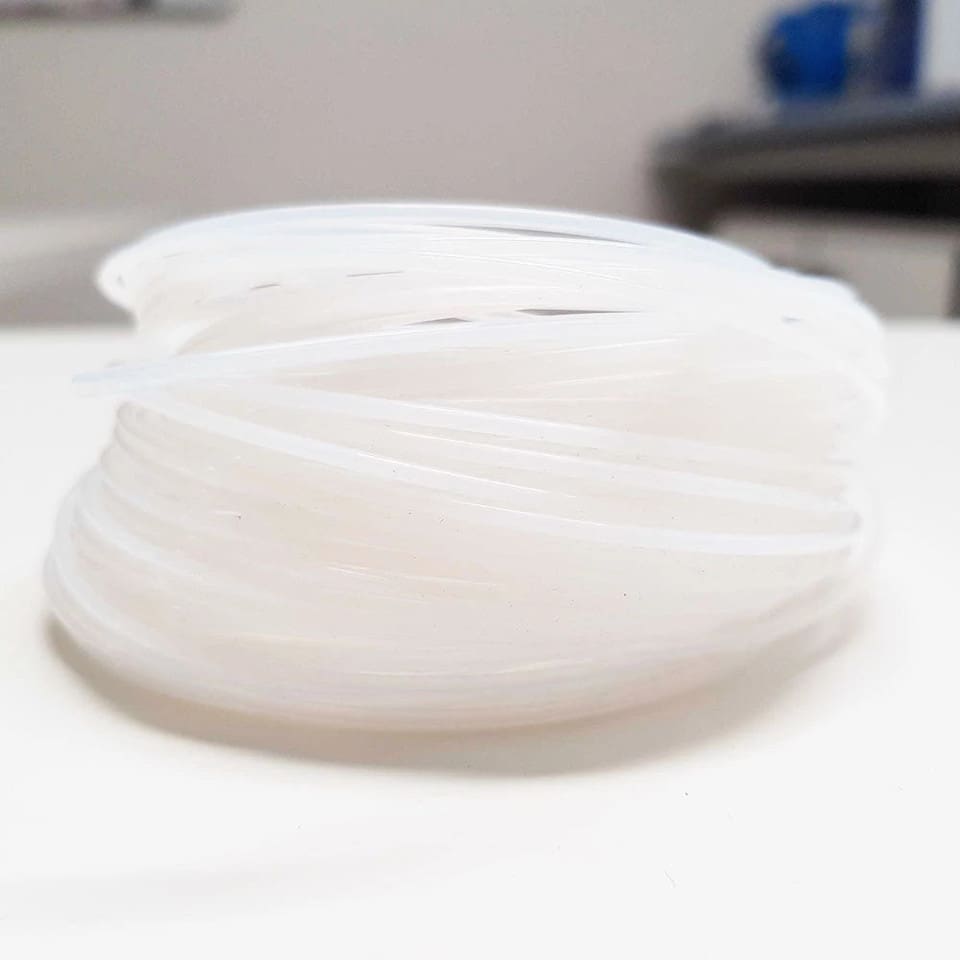Two of the most common fluoropolymers used for tubing in microfluidics are PTFE (polytetrafluoroethylene) and PFA (perfluoroalkoxy alkane). Both provide excellent chemical resistance, thermal stability, and non-stick properties — which is why they are widely used in chemical processing, medical devices, semiconductors, and even cookware.
In microfluidics, however, the details matter. Small differences in flexibility, purity, and ease of processing can significantly affect flow control, device integration, and long-term performance.
This article breaks down the key similarities and differences between PTFE and PFA tubing, provides practical scenarios, and answers common questions to help you choose the right material for your system.
PTFE vs PFA: Quick Comparison Table
Before diving into the details, here’s a quick comparison table highlighting the key properties of PTFE and PFA tubing. It provides an overview of how these two fluoropolymers differ in chemical resistance, flexibility, and other factors important for microfluidic and broader applications.
| Property | PTFE | PFA | Preferred Material |
|---|---|---|---|
| Chemical Resistance | Excellent inertness to most chemicals | Excellent inertness, with higher purity levels | Both |
| Coefficient of Friction | 0.03–0.05 | 0.05–0.08 | PTFE |
| Coefficient of Thermal Expansion (between 21 and 100°C) | 14 × 10⁻⁵ /K | 12 × 10⁻⁵ /K | PFA |
| Cold Flow Resistance | >10% at 6.9 MPa | >2% at 6.9 MPa | PFA |
| Compressive Strength | 11–13 MPa | 12–15 MPa | PFA |
| Cost | Relatively inexpensive | Relatively costly | PTFE |
| Dielectric Strength | ~20 kV/mm | ~80 kV/mm | PFA |
| Elongation | 350–400% | 260–300% | PTFE |
| Flexural Modulus | 345–620 MPa | 590–690 MPa | Application Dependent |
| Hardness (Shore D) | ~55 | ~55 | Both |
| Machinability | Excellent | Excellent | Both |
| MIT Folding Endurance | Up to 1 × 10⁶ cycles | ~5 × 10⁵ cycles | PTFE (better durability in flexing) |
| Service Temperature | -71 °C to 260 °C | -71 °C to 260 °C | Both |
| Tensile Strength | 24.8 MPa | 33 MPa | PFA |
| Thermal Conductivity | ~0.25 W/m·K | ~0.2 W/m·K | PTFE (slightly better heat transfer) |
| Water Absorption | less than 0.01% | less than 0.03% | PTFE |
💡 Note: The values presented in this table are for reference purposes only. Actual properties may vary depending on the supplier, as factors such as size, grade, and brand can influence performance. Both PTFE and PFA are often available with customized specifications to meet specific application requirements.
PTFE vs PFA: Material Overview
To better understand their performance in microfluidics and beyond, it is important to take a closer look at what PTFE and PFA are, along with their key properties and common use cases.
About PTFE
PTFE is a synthetic fluoropolymer best known under the trade name Teflon. Built from long carbon chains fully bonded to fluorine atoms, it is chemically inert, highly hydrophobic, and exceptionally resistant to heat, wear, and aggressive chemicals. Its non-stick surface and very low friction coefficient make it valuable in both industrial and consumer products.
PTFE is widely used in microfluidics for tubing and sealing components, and beyond that, in cookware coatings, chemical tanks, gaskets, seals, aerospace parts, and electrical insulation where durability under extreme conditions is essential.
About PFA
PFA is a copolymer of PTFE designed to offer greater flexibility and easier processing. Unlike PTFE, it can be melt-processed through extrusion and injection molding, enabling smoother surfaces and high-purity components. It combines broad chemical resistance with transparency, excellent dielectric strength, and the ability to withstand continuous use up to 260 °C.
These traits make it a strong choice in microfluidics, particularly for high-purity tubing and labware, as well as in semiconductor manufacturing, medical devices, chemical processing, and heat exchangers, where clarity and resistance to stress cracking are needed.
Side-by-Side Comparison
While PTFE and PFA share many core traits, their subtle differences become clear when compared across mechanical performance, cost, chemical resistance, and practical use.
Mechanical Properties
PFA generally offers greater flexibility and better resistance to stress cracking, which makes it attractive for tubing applications where bendability is important. However, its ability to withstand repeated folding (flex life) is lower than that of PTFE.
PTFE, while slightly less flexible, performs better in situations that involve continuous or repetitive bending over time. PFA on the other hand, is stiffer and has lower elongation but provides better dimensional stability under mechanical stress.
Additionally, PFA offers slightly higher tensile and compressive strength than PTFE, which makes it slightly more suitable for high-pressure fluid systems or mechanically demanding setups.
Chemical & Temperature Resistance
Both PTFE and PFA are highly resistant to a wide range of chemicals, including strong acids, bases, and solvents.
PTFE stands out for its superior hydrophobicity and lower susceptibility to water absorption and weathering, which helps maintain flow stability in microfluidic systems. PFA, while slightly more prone to hydro-absorption, performs better in salt spray environments and maintains excellent chemical stability under prolonged exposure.
In terms of temperature, PTFE offers slightly higher maximum heat resistance, while PFA provides good thermal stability with slightly higher creep under long-term stress. Both materials can operate continuously up to around 260 °C.
Surface & Electrical Properties
PTFE features a lower coefficient of friction, minimizing fluid interaction and buildup in tubing. PFA provides smoother inner surfaces, which is particularly beneficial in high-purity microfluidic setups. Additionally, PFA has a dielectric strength three to four times higher than PTFE, making it more suitable for applications requiring electrical insulation.
Cost
PTFE is generally more economical and widely available, while PFA comes at a higher cost due to its enhanced processing and purity.
Typical Applications
PTFE is widely used for flexible microfluidic tubing, seals, gaskets, and insulating components where chemical inertness, durability, and low friction are critical. PFA is preferred in high-purity fluid handling, laboratory equipment, semiconductor processes, and medical systems, where smooth surfaces, chemical cleanliness, and flexibility are important.
How to Choose Between PTFE and PFA?
Selecting between PTFE and PFA tubing depends less on which is “better” overall and more on which material aligns with the specific needs of your system. Below are some common scenario-based recommendations to help guide your decision.
1. If chemical resistance is your top priority:
Both materials handle harsh chemicals extremely well, but PTFE’s stronger hydrophobic nature and lower water absorption make it more reliable for long-term use in microfluidic systems exposed to moisture or mixed solvents.
2. If high flexibility is required:
PFA tubing offers better bendability, which is useful when routing tubing in tight spaces or compact microfluidic setups. However, if the tubing will be subject to repetitive folding or constant motion, PTFE’s superior flex life ensures longer durability.
3. If your application involves high purity demands:
For semiconductor, pharmaceutical, or medical microfluidics, PFA is often the safer choice. Its smoother interior surface and lower risk of contamination provide more stable and predictable flow behavior.
4. If cost is a deciding factor:
PTFE is usually more budget-friendly and widely available, making it the go-to choice for many standard chemical and microfluidic applications.
5. If the application involves mechanical stress or pressure:
For tubing that must withstand high pressures or mechanical loads, PFA’s superior tensile and compressive strength makes it more reliable, ensuring dimensional stability and long-term performance under demanding conditions.
6. If electrical insulation is needed:
PFA’s much higher dielectric strength makes it advantageous for applications where tubing also serves an insulating or protective role.
👉 In short:
- Choose PTFE when cost-efficiency, hydrophobicity, and long flex-life are most important.
- Choose PFA when purity, smooth flow paths, and mechanical strength under pressure are non-negotiable.
PTFE vs PFA: Frequently Asked Questions
To wrap up, here are answers to some common questions about PTFE and PFA tubing, helping you quickly identify which material suits your microfluidic application.
Q1: Which material is more flexible, PTFE or PFA?
PFA is generally more flexible and easier to bend, making it suitable for compact tubing layouts. However, PTFE offers a longer flex life, so it tolerates repeated folding and mechanical stress better.
Q2: Which tubing is better for chemical resistance?
Both PTFE and PFA exhibit excellent chemical resistance. PTFE’s stronger hydrophobicity and lower water absorption make it slightly more reliable in microfluidic setups exposed to moisture or mixed solvents, while PFA performs equally well in high-purity and corrosive environments.
Q3: Can PTFE and PFA tubing be used interchangeably?
Not always. While they share many properties, differences in flexibility, tensile strength, thermal stability, and processability mean the choice should depend on your specific application requirements.
Q4: Which material handles higher temperatures?
PTFE has a slight edge in maximum heat resistance and long-term thermal stability. Both can operate continuously up to around 260 °C (500 °F).
Q5: Which tubing is more cost-effective?
PTFE is generally less expensive due to simpler processing and wider availability. PFA’s enhanced mechanical properties and smooth, high-purity surfaces come at a higher cost.
Q6: When should I choose PFA over PTFE?
PFA is preferred when tubing must be highly flexible, mechanically robust under pressure, or meet strict purity and surface smoothness standards, such as in microfluidics, semiconductor, pharmaceutical, or medical applications.
Q7: When should I choose PTFE over PFA?
PTFE is a better choice when durability, long flex life, chemical inertness, and cost efficiency are priorities, especially in standard chemical processing or microfluidic setups where repeated bending or exposure to moisture occurs.
💡 Conclusion
PTFE and PFA remain two of the most versatile and widely used fluoropolymers for tubing across microfluidics and other industries. Understanding their properties and differences ensures you select the right material for your specific needs, improving reliability, performance, and longevity.
Stay tuned for more deep dives into material choices for microfluidics, comparing tubing, connectors, and other component materials to help you make the best selection 🔬!
📧 If you have any questions or feedback, please feel free to contact us at contact@darwin-microfluidics.com.
🔗 References
- Substech. Perfluoroalkoxy (PFA). https://www.substech.com/dokuwiki/doku.php?id=perfluoroalkoxy_pfa
- Substech. Thermoplastic Polytetrafluoroethylene (PTFE). https://www.substech.com/dokuwiki/doku.php?id=thermoplastic_polytetrafluoroethylene_ptfe
- Kern. Polytetrafluoroethylene (PTFE) Technical Datasheet. https://www.kern.de/de/technical-datasheet/polytetrafluoroethylene-ptfe?n=1601_2
- PTFE DF. PTFE vs PFA: A Brief Comparison Guide. https://ptfedf.com/ptfe-vs-pfa-a-brief-comparison-guide/
- DifferenceBetween.net. Difference Between PFA and PTFE. https://www.differencebetween.net/science/chemistry-science/difference-between-pfa-and-ptfe/
- Process Technology. PFA vs PTFE – What’s the Difference? https://www.processtechnology.com/pfa-ptfe-whats-the-difference/#:~:text=PTFE%20has%20a%20slightly%20higher,superior%20in%20salt%20spray%20resistance



